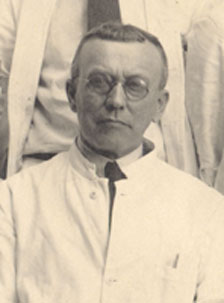George Dock, MD
1860 — 1951

George Dock was the consummate academic internist and pathologist and his bibliography touches on all issues in the medicine of his times, from tuberculosis and leprosy to coronary disease and social medicine.
Dock was born in Hopewell, Pennsylvania and educated at the U. of Pennsylvania. He is relevant to the history of CVD epidemiology as an unsung describer of coronary occlusion and survival, the ante mortem diagnosis of myocardial infarction being the greatest stimulus to research and understanding of coronary disease. His description of 5 cases of coronary disease includes one of a 64 year old previously well, lumber dealer who had experienced a severe bout of chest pain a week before admission. Dock wrote in a report at the U. of Buffalo May 5, 1896: “The diagnosis was myomalacia following coronary sclerosis, with secondary pericarditis. This was based on the history of increasing dyspnea and heart pain, without evidence of disease in lungs or kidneys, or other (valvular) disease of the heart, the history of the acute attack indicating infarction, and the acute onset of pericarditis without other cause.” This was 13 years before the report of Obrastzow and 20 years before that of Herrick, those usually given credit for priority in ante mortem diagnosis of cardiac infarction.
Dock influenced American medicine from his many posts at Pennsylvania, during the time of Sir William Osler’s visit, and at Galveston, Michigan, Tulane, and Washington University. His occupation after retirement at age 62 is described as “bibliophile.” (HB)